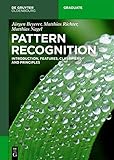Pattern Recognition : Introduction, Features, Classifiers and Principles / Jürgen Beyerer, Matthias Richter, Matthias Nagel.
By: Beyerer, Jürgen [author.] .
.
Contributor(s): Beyerer, Jürgen [contributor.] | Nagel, Matthias [author.]
| Nagel, Matthias [author.] | Nagel, Matthias [contributor.]
| Nagel, Matthias [contributor.] | Richter, Matthias [author.]
| Richter, Matthias [author.] | Richter, Matthias [contributor.]
| Richter, Matthias [contributor.] .
.
Material type:  BookSeries: De Gruyter Textbook.Publisher: München ; Wien : De Gruyter Oldenbourg, [2017]Copyright date: ©2018Description: 1 online resource (XXVIII, 283 p.).Content type: text Media type: computer Carrier type: online resourceISBN: 9783110537949.Subject(s): Pattern recognition systems
BookSeries: De Gruyter Textbook.Publisher: München ; Wien : De Gruyter Oldenbourg, [2017]Copyright date: ©2018Description: 1 online resource (XXVIII, 283 p.).Content type: text Media type: computer Carrier type: online resourceISBN: 9783110537949.Subject(s): Pattern recognition systemsFrontmatter -- Preface -- Contents -- List of Tables -- List of Figures -- Notation -- Introduction -- 1. Fundamentals and definitions -- 2. Features -- 3. Bayesian decision theory -- 4. Parameter estimation -- 5. Parameter free methods -- 6. General considerations -- 7. Special classifiers -- 8. Classification with nominal features -- 9. Classifier-independent concepts -- A. Solutions to the exercises -- B. A primer on Lie theory -- C. Random processes -- Bibliography -- Glossary -- Index
restricted access online access with authorization star
http://purl.org/coar/access_right/c_16ec
The book offers a thorough introduction to Pattern Recognition aimed at master and advanced bachelor students of engineering and the natural sciences. Besides classification - the heart of Pattern Recognition - special emphasis is put on features, their typology, their properties and their systematic construction. Additionally, general principles that govern Pattern Recognition are illustrated and explained in a comprehensible way. Rather than presenting a complete overview over the rapidly evolving field, the book is to clarifies the concepts so that the reader can easily understand the underlying ideas and the rationale behind the methods. For this purpose, the mathematical treatment of Pattern Recognition is pushed so far that the mechanisms of action become clear and visible, but not farther. Therefore, not all derivations are driven into the last mathematical detail, as a mathematician would expect it. Ideas of proofs are presented instead of complete proofs. From the authors' point of view, this concept allows to teach the essential ideas of Pattern Recognition with sufficient depth within a relatively lean book. Mathematical methods explained thoroughly Extremely practical approach with many examples Based on over ten years lecture at Karlsruhe Institute of Technology For students but also for practitioners
The book offers a thorough introduction to Pattern Recognition aimed at master and advanced bachelor students of engineering and the natural sciences. Besides classification - the heart of Pattern Recognition - special emphasis is put on features, their typology, their properties and their systematic construction. Additionally, general principles that govern Pattern Recognition are illustrated and explained in a comprehensible way. Rather than presenting a complete overview over the rapidly evolving field, the book is to clarifies the concepts so that the reader can easily understand the underlying ideas and the rationale behind the methods. For this purpose, the mathematical treatment of Pattern Recognition is pushed so far that the mechanisms of action become clear and visible, but not farther. Therefore, not all derivations are driven into the last mathematical detail, as a mathematician would expect it. Ideas of proofs are presented instead of complete proofs. From the authors' point of view, this concept allows to teach the essential ideas of Pattern Recognition with sufficient depth within a relatively lean book. Mathematical methods explained thoroughlyExtremely practical approach with many examplesBased on over ten years lecture at Karlsruhe Institute of TechnologyFor students but also for practitioners
Mode of access: Internet via World Wide Web.
In English.
Description based on online resource; title from PDF title page (publisher's Web site, viewed 30. Aug 2021)


There are no comments for this item.